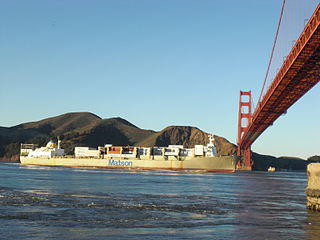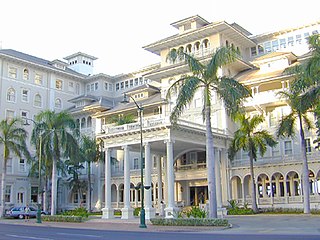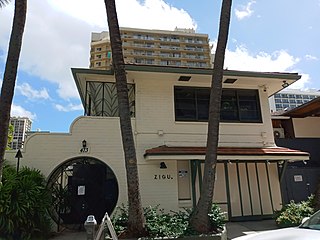
Honolulu is the capital and most populous city of the U.S. state of Hawaii, located in the Pacific Ocean. It is the county seat of the consolidated City and County of Honolulu, situated along the southeast coast of the island of Oʻahu, and is the westernmost and southernmost major U.S. city. Honolulu is Hawaii's main gateway to the world. It is also a major hub for business, finance, hospitality, and military defense in both the state and Oceania. The city is characterized by a mix of various Asian, Western, and Pacific cultures, reflected in its diverse demography, cuisine, and traditions.

The ʻIolani Palace was the royal residence of the rulers of the Kingdom of Hawaiʻi beginning with Kamehameha III under the Kamehameha Dynasty (1845) and ending with Queen Liliʻuokalani (1893) under the Kalākaua Dynasty, founded by her brother, King David Kalākaua. It is located in the capitol district of downtown Honolulu in the U.S. state of Hawaiʻi. It is now a National Historic Landmark listed on the National Register of Historic Places. After the monarchy was overthrown in 1893, the building was used as the capitol building for the Provisional Government, Republic, Territory, and State of Hawaiʻi until 1969. The palace was restored and opened to the public as a museum in 1978. ʻIolani Palace is the only royal palace on US soil.

The Ala Moana Center, commonly known simply as Ala Moana, is a large open-air shopping mall in the Ala Moana neighborhood of Honolulu, Hawaii. Owned by Brookfield Properties, Ala Moana is the eighth largest shopping mall in the United States and the largest open-air shopping center in the world.

Matson, Inc., is an American shipping and navigation services company headquartered in Honolulu, Hawaii. Founded in 1882, Matson, Inc.'s subsidiary Matson Navigation Company provides ocean shipping services across the Pacific to Hawaii, Alaska, Guam, Micronesia, the South Pacific, China, and Japan.

The Territory of Hawaii or Hawaii Territory was an organized incorporated territory of the United States that existed from April 30, 1900, until August 21, 1959, when most of its territory, excluding Palmyra Island, was admitted to the United States as the 50th US state, the State of Hawaii. The Hawaii Admission Act specified that the State of Hawaii would not include Palmyra Island, the Midway Islands, Kingman Reef, and Johnston Atoll, which includes Johnston Island and Sand Island.

The Moana Hotel is a historic hotel building in Honolulu, Hawaii, located at 2365 Kalākaua Avenue in the Waikiki neighborhood. Built in the late 19th century as the first hotel in Waikiki, the Moana opened in 1901. It is listed on the National Register of Historic Places. The hotel was also inducted into Historic Hotels of America, the official program of the National Trust for Historic Preservation, in 1989. The building is currently part of the resort complex known as Moana Surfrider, A Westin Resort & Spa and is managed by Westin Hotels & Resorts.

The Royal Hawaiian Hotel is a beachfront luxury hotel located in Waikiki in Honolulu, Hawaii, on the island of Oahu. It is part of The Luxury Collection brand of Marriott International. One of the first hotels established in Waikiki, the Royal Hawaiian is considered one of the most luxurious and famous hotels in Hawaiian tourism and has hosted numerous celebrities and world dignitaries. The bright pink hue of its concrete stucco façade with its Spanish/Moorish styled architecture and prominent location on the wide sandy beach have earned it the alliterative nickname of "The Pink Palace of the Pacific".

ʻĀinahau was the royal estate of Princess Victoria Kaʻiulani, heir to the throne of the Kingdom of Hawaiʻi.

The Sheraton Princess Kaiulani Hotel is a large resort hotel in Honolulu, Hawaii.

The Waikiki Natatorium War Memorial is a war memorial in Honolulu, Hawaii, USA, built in the form of an ocean water public swimming pool. The Natatorium was built as a living memorial dedicated to "the men and women who served during the great war".
Alexander & Baldwin, Inc. is an American company that was once part of the Big Five companies in territorial Hawaii. The company currently operates businesses in real estate, land operations, and materials and construction. It was also the last "Big Five" company to cultivate sugarcane. As of 2020, it remains one of the State of Hawaii's largest private landowners, owning over 28,000 acres (11,000 ha) and operating 36 income properties in the state.

The No. 1 Capitol District Building, also known as the Hemmeter Building, is a 134,000-square-foot building (12,400 m2) on two acres (0.81 ha) in downtown Honolulu, Hawaii, United States. Formerly known as the Armed Services YMCA Building, it houses the Capitol Modern Museum, the Hawaii State Foundation on Culture and the Arts, and state offices.

Oliver Green Traphagen was an American architect who designed many notable buildings in Duluth, Minnesota, during the late 19th century and in the Territory of Hawaii during the early 20th century. Among his most famous landmarks are the Oliver G. Traphagen House in Duluth, called the Redstone, and the Moana Hotel in Honolulu, both of which are on the National Register of Historic Places, as are several other buildings he designed.
Charles William “C.W.” Dickey was an American architect famous for developing a distinctive style of Hawaiian architecture, including the double-pitched Dickey roof. He was known not only for designing some of the most famous buildings in Hawaiʻi—such as the Alexander & Baldwin Building, Halekulani Hotel, Kamehameha Schools campus buildings—but also for influencing a cadre of notable successors, including Hart Wood, Cyril Lemmon, Douglas Freeth, Roy Kelley, and Vladimir Ossipoff.

The Kakaʻako Pumping Station in Honolulu, Hawaii was designed by architect Oliver G. Traphagen in the Richardsonian Romanesque style. He also designed many such bold stone public works buildings in Duluth, Minnesota.

Hart Wood was an American architect who flourished during the "Golden Age" of Hawaiian architecture. He was one of the principal proponents of a distinctive "Hawaiian style" of architecture appropriate to the local environment and reflective of the cultural heritage of the islands. He was one of the three founders of the Honolulu Chapter of the American Institute of Architects, and the only one of its fourteen charter members to be elected a Fellow of the AIA. He served as territorial architect during World War II.

Historic Hotels of America is a program of the National Trust for Historic Preservation that was founded in 1989 with 32 charter members; the program accepts nominations and identifies hotels in the United States that have maintained their authenticity, sense of place, and architectural integrity.

The Mabel Smyth Memorial Building is a historic building in Honolulu, Hawaii. It was designed by Charles W. Dickey in 1937 and built in 1941. It was added to the National Register of Historic Places on February 3, 1994.

The Cooper Apartments, also known as Seaside Apartments, is a historic apartment building located at 421–425 Seaside Avenue in Honolulu, Hawaii, U.S.. Constructed in 1939 during the Great Depression, the building is a distinguished example of a pre-war garden court apartment in Waikiki, embodying a transition between Streamline Moderne and the emerging tropical modern style, a fusion between Modern architecture and borrowing from Asian and South American vernacular architecture. This architectural style is characterized by its clean lines and simple aesthetic, reflecting the economic austerity of the time.

Edwin Leo Bauer was an American architect, whose mid-20th-century work significantly influenced the architectural landscape of Honolulu, Hawaii. His designs, characterized by innovative use of space and materials, played a substantial role in defining the era of Hawaii Mid-Century Modern architecture.



















